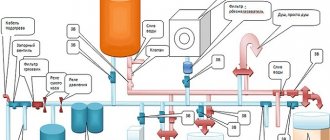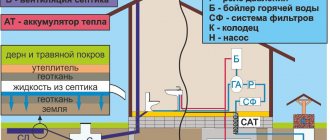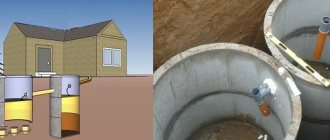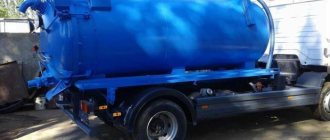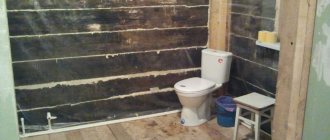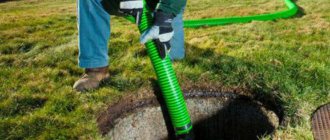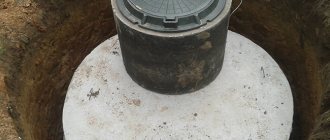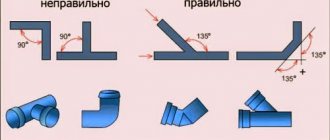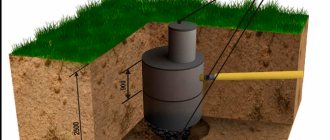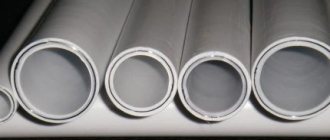The article is posted in the category|subcategory
- Plumbing and plumbing
- Internal water supply
Author
Alexander Chernyakhin
—
Aug 11, 2015 Updated: March 13, 2016
- 1 Selecting a wiring diagram
- 2 Main components of the circuit
- 3 Sequence of water supply scheme
- 4 Selection of pipes 4.1 Diameter of communications
- 4.2 Pipe material
Do-it-yourself water supply in a private house can be done from a central water supply or from a well (well). The principles of its creation, the main components of the system in each of these cases are virtually the same.
Selecting a wiring diagram
There are two ways to supply water to points of consumption, and the choice of a water supply layout in a private house with your own hands depends on the parameters of the system, as well as on the intensity of water consumption (permanent or periodic residence, number of residents, etc.).
Serial connection
This connection is also called a tee connection . The tap, shower and other points are connected in series. This method requires the use of fewer materials (pipes, fittings, etc.), and is therefore cheaper.
The disadvantage of a series connection when laying out a water supply system is the likelihood of a decrease in pressure pressure at the most remote points when several water intake points are used simultaneously.
Collector connection
A collector (or parallel ) connection is the organization of a collector (or two collectors - hot and cold water supply), to which lines leading to each water intake point are connected. To implement such a scheme, a larger number of pipes will be required, but its operating principle allows for stable pressure .
Tee and manifold circuits for water distribution in the house
There are additional nuances when choosing the principle of water supply. Do-it-yourself installation of water supply in a private house can be done in two ways:
- "Blind" lines ending in a dead end (stub) . This scheme for wiring the water supply system in the house is more economical, however, when supplying hot water, it can create some inconvenience - when opening the tap, you must wait a certain time until the liquid reaches the plug, and only after that hot water appears in the tap.
- Closed circulation lines are more practical and convenient, however, to implement such a project, you will need not only a larger number of pipes, but also a special circulation pump.
Experts recognize the most rational combination option, in which the “blind” cold water distribution is combined with a hot water supply circulation line.
Types of plumbing schemes
Serial type
In another way, this type of wiring is called tee. In this scheme, pipes from the riser lead to each plumbing fixture in turn. First of all, common branches are laid, from them, using tees, pipes are taken to the consumption nodes.
The method is considered inexpensive in relation to others. The scheme requires few pipes and fittings. The method is simple to install yourself. Pipes take up little space and are easy to hide behind the trim.
Attention! With a tee circuit, differences in hot water occur if several points of consumption operate simultaneously.
This type is more suitable for use in high-rise buildings, or in houses where people live periodically. The pressure in the water supply does not remain the same when there is a heavy load on the system. At the farthest point of the diagram, the pressure will be weak.
During repairs, you will need to turn off the water supply to the entire house. For a private house in which people live all year round, and there are many residents, you should choose a parallel type of wiring.
Parallel type
In another way, this type is called collector. The scheme involves connecting each pipe to the consumption nodes from one collector. Install two collectors for hot and cold water separately.
A large number of pipes are installed in the scheme; they are difficult to hide. In this case, the pressure in the tubes is maintained regardless of the load on the system and the distance of the device.
The collector device is a structure that has one inlet for liquid, several outlets going to the plumbing, consuming water. The collector distributing cold water should be placed next to the pipe entry into the room; the collector distributing hot water should be located near the outlet of the liquid from the water heating device. The collector is equipped with a cleaning filter and a pressure reducer. The filter must be placed before the water enters the collector.
Attention! A valve is installed on the pipe leaving the collector to turn off the water supply to each device, while the remaining branches do not stop their operation. You can also install a regulator on each pipe to maintain the required pressure for a separate device.
Main components of the circuit
The water distribution diagram in a private house, or more precisely, the part of it that is responsible for supplying water to the house, consists of the following main components:
- pumping unit for a well or borehole,
- nipple (adapter),
- check valve preventing water backflow,
- pipeline,
- filter equipment (one or more different filters depending on water quality),
- shut-off valves,
- hydraulic accumulator,
- five-piece (fitting) for connecting the main elements and instruments (pressure gauge, pressure switch, pipes).
Elements of the water supply system of a country house with a well
Sequence of water supply scheme
In order to visualize how to install water in a private house with your own hands, you can consider the flow of communications from the source to the end point.
1. An individual water unit (well or borehole) is equipped with pumping equipment, the selection of which is carried out according to the following principles:
- for deep artesian wells only submersible pumps can be used,
- for narrow channels and casing pipes - only surface units, including pumping stations,
- in other cases, the choice between submersible and external equipment is made depending on the technical characteristics of specific models and operating conditions.
2. The pipeline supplying water to the house is usually laid underground. The depth of the trench is usually selected taking into account the depth of soil freezing in a given region. As additional protection against freezing, communications are equipped with a thermal insulation layer.
Conducting water supply to a house from a well with a caisson
3. The point at which the pipeline enters the house deserves special attention.
- Firstly, the hole for the pipe is made with a large margin - a gap of at least 150 mm on all sides. This allows you to avoid deformation and destruction of communications if over time the wall begins to sag or deform.
- Secondly, a small section of pipe, located between underground and ground-protected communications and internal wiring in a warm room, is located in the open air. This is where the risk of pipeline freezing is highest, so good thermal insulation is required.
4. The hydraulic accumulator and control devices are installed, as a rule, in the basement, basement or on the first floor near the point of entry of the pipeline into the house. Technically, it would be more correct to place such equipment at the highest point, but from the point of view of practicality and ease of use, lower levels are more suitable. You just need to take into account the need to raise water to the upper floors when setting the pressure switch.
The hydraulic accumulator is designed to stabilize pressure in communications and prevent frequent switching on (and, accordingly, rapid wear) of pumping equipment.
The control and monitoring unit includes a pressure gauge, a pressure switch and a dry-running relay , which prevents air entrapment and the formation of air locks in the system when the water level in the well or well decreases.
5. Filter systems are equipped, depending on the need, with devices for:
- preliminary rough removal of large particles of impurities (more about main water filters for a private house),
- fine cleaning,
- reduction in iron content,
- water softening.
Afterwards, you install the water supply system in a private house with your own hands according to the chosen scheme. For a collector circuit it might look like this:
- Immediately behind the accumulator there is a tee along with a shut-off valve. The tee divides the flow of water into two directions - into the house and for other needs (watering, car washing, etc.);
- A deep cleaning filter is connected;
- Next comes a tee, from which the distribution of water supply pipes in a private house is divided into a pipe for cold water, which immediately goes to the cold water collector, and into a pipe through which water will go to a boiler or other water heater for heating. After heating, the water is sent to the hot water manifold.
The photo shows a diagram of water distribution in a private house
Important: When installing water supply in a private house with your own hands using a collector circuit, it is necessary to install shut-off valves at each point of water consumption.
Features of water supply separation
There are types of installation of cold and hot water supply
Two installation methods:
1. using blind wiring, in which there is a dead end at the end of the pipe supplying water to the extreme consumption node. The installation scheme is economical, but more problematic for operation. Water enters the end device with a delay; first it reaches the plug, then flows into the tap.
2.using a closed circulation type wiring. The liquid in the system flows in a closed circle with the same temperature at all points and is immediately supplied to the tap without delay. This installation method is suitable for installing hot water to avoid temperature surges in the system.
Attention! The simplest option for the home is considered to be laying using a combined method. Cold water supply is installed using a blind method, while hot water supply is installed using a circulation method.
Drafting
To draw up a wiring plan, you must have a floor plan.
This drawing indicates the location of the plumbing that is planned to be connected to the water supply pipes. The dimensions on the plan must be observed for all devices. An accurate plan will help you calculate how many fittings and pipes will be needed. The diagram should indicate the water intake units, the length of the pipes, the location of the water supply and sewerage elements, because they are interconnected. All filters, boiler and pump power should be taken into account.
The diagram should be as simple as possible, without intersecting contours. Sewage and water supply pipes are laid as close to each other as possible in order to hide them behind one finishing structure. If the pipes pass under the floor, the tees lead perpendicularly upward.
Attention! When developing a project, you need to rely on current building codes and drainage rules.
How to install water supply units
A standard water supply scheme, including a well or a well, may involve a sequential connection to the pipeline.
The circuit has the following nodes:
1.Pump. For wells with a depth of more than eight meters, a submersible pump can be used. In shallow wells, surface-type pumps are used.
2. Nipple for transfer. It is necessary to connect system elements whose cross-section does not coincide with the size of the outlet of the pumping equipment.
3.Check valve to prevent fluid from flowing out of the pipes when the pump is not running.
4.Pipes. Pipes made of polypropylene material, metal-plastic, and steel are suitable for water supply. The type of wiring affects the material of the pipes. Pipes are laid openly, closed, outside or inside the building. The pipes through which water enters the room are equipped with thermal insulation.
5. Fittings for water supply. Needed to connect pipes, shut off water, and make pipeline turns. These are different valves, fittings, tees.
6.Cleaning filters. Necessary to protect devices from contamination by solid particles, reduce the level of iron in water, and make the water softer.
7.Hydraulic accumulator tank. Maintains constant water pressure in the system, protects pumps from constant operation.
8. Security group devices. They provide control over pressure in pipes; they include a pressure gauge with a relay that regulates pressure, dry running. The devices operate automatically and extend the service life of the equipment.
Plumbing equipment is connected in strict sequence. The collector in houses is installed in a separate room: boiler room, boiler room, or on a designated floor, in the basement. If the house has many floors, then installation of collectors is required on each. If the house is compact, then one collector is placed behind the toilet cistern, putting it away in a special cabinet. The manifold should be located where there is most plumbing to save on pipes, and so that it is equidistant from each fixture.
Features of collector installation
The collector unit is mounted, directing it along the flow of water. The work is carried out in the following sequence:
1.In the place where the collector and the main pipe supplying water are connected, install a shut-off valve. It is necessary to quickly turn off the water flow if necessary.
2. then comes the installation of a sediment filter from large suspensions of mechanical origin, which can break the plumbing.
3.installation of a filter for smaller particles, ten to one hundred and fifty microns in size.
4.Then it is necessary to install a check valve, which protects the system from backflow if the pressure in the pipes drops.
When the connection of the auxiliary equipment is completed, a collector device is connected to the pipe for supplying liquid, having outputs equal in number to the points of consumption.
Attention! Unused terminals on the collector are equipped with plugs; they can be used later.
Open and closed type of pipe laying
There are ways to lay out contours in the house: open, closed. The methods do not change the operation of the entire water supply system or its quality. The choice depends on desire.
The closed type of gasket allows you to save space in the room up to ten centimeters. The method creates an aesthetic appearance. If the pipes in the system are made of polypropylene, then a hidden gasket can be used. The pipeline is removed behind a decorative plasterboard wall, or the elements are placed in specially made niches in the wall, then plaster and cladding are laid.
Pipes should not be laid too close to surfaces to allow repairs to be made. If pipes are laid in a monolith, the contours should be placed in a casing in the form of a pipe. The main disadvantage of this method is that if repairs are necessary, the cladding will have to be removed and then decorated. It is difficult to detect leaks in the early stages.
To avoid complications, it is recommended to hide monolithic sections of systems; all fittings for connections should be placed in visible places. Hatches are constructed for valve fittings for easy inspection and repair.
Attention! Pipes made of copper, polypropylene, or metal-plastic materials can be removed under the plaster.
If you use an open type of installation, then first complete the finishing. The pipes are not covered with anything, which does not look so aesthetically pleasing and takes up space in the room. But with this installation method it is easy to repair the tubes if necessary. This method allows you to quickly see areas with defects and eliminate them.
Pipe selection
Diameter of communications
When installing water supply into a private house with your own hands, the correctly selected pipe diameter will ensure efficiency at the installation stage of the system, as well as avoid unpleasant noise when water moves through communications.
To calculate the parameters of lines supplying water to points of consumption, the starting point is the total length of each line :
- for a branch less than 10 meters long, pipes with a diameter of 16-20 mm can be used,
- for branches of about 30 meters - with a diameter of 25 mm,
- For the longest lines over 30 meters, pipes with a maximum diameter of 32 mm are required.
Important: Particular attention should be paid to choosing the diameter of the collector pipe. An insufficient value can cause problems in the system.
The distribution of water in a private house from the collector is calculated based on the fact that each tap has a throughput capacity of about 5 liters per minute. After this, roughly calculate how much water is taken simultaneously from all points at peak moments and select the diameter of the collector:
- 25 mm for a flow rate of 30 l/min,
- 32 mm for 50 l,
- 38 mm for 75 l.
Pipe material
Laying a water supply system in a private house allows you to use pipes made of various materials, each of which has its own advantages, disadvantages and operating features.
- Copper pipes are quite expensive, but their performance is unrivaled. They are corrosion resistant, strong and durable.
- Metal-plastic products are metal-plastic water pipes, aluminum pipes coated with polyethylene on the outside and inside. This layered structure allows for anti-corrosion resistance and strength. The advantage of metal-plastic structures is also their resistance to deposit formation. Limitations on the use of such communications are imposed by their low resistance to high temperatures - the pipes can withstand no more than 95° C. In this regard, it is more rational to use them for a cold water supply system.
- Steel pipes could be called the ideal combination of good performance and reasonable price, if not for their susceptibility to corrosion. When installing a water supply system from such products, you will also have to cut a thread on each section, since there are no special devices for connecting steel pipes. Recently, they are used less and less when installing water pipes in a country house.
- Polypropylene communications are durable and practical. At the same time, they can be classified as cost-effective solutions. The only inconvenience is that installation requires special equipment. But it should be noted that the equipment is inexpensive, and almost everyone can quickly learn how to use it.
If you decide to go with polypropylene, it will be useful for you to know how to weld polypropylene pipes.
Read more about the difference between collector and tee water supply wiring schemes here.
Since you will need coarse water filters, we advise you to familiarize yourself with their types.
The main methods of installing water supply in an apartment
There are two main schemes for distributing water supply in an apartment: tee, also known as sequential, and also collector. Both schemes have certain advantages and disadvantages, so they are used for different situations. In addition, sometimes it makes sense to combine both of these schemes.
Method #1. Series (tee) circuit
This is the easiest way to design and implement plumbing in a typical apartment. This scheme consists of one common pipe, to which all devices - consumers of cold tap water - are connected in series. In the same way, a hot water supply system is installed in parallel.
The main pipe must be larger in diameter than the rest of the water supply, since it functions as a collector in this system. Tees are used to connect plumbing fixtures, which is why this scheme is often called a tee.
The advantage of a sequential wiring diagram for the plumbing system in an apartment is that this scheme is very simple and requires minimal implementation costs
The principle of such a system is very simple both for design and implementation. Water supply is organized in a similar way in almost all apartments built according to standard Soviet designs. One of its significant advantages is the small number of water pipes. Therefore, the costs of creating such a water supply system will be minimal.
This diagram demonstrates in sufficient detail the structure and operating principle of a sequential water supply wiring diagram in an apartment, which is also called a tee
But such a plumbing system is only suitable for the small apartments described above with a small amount of plumbing. The fact is that the longer such a system, the lower the water pressure at the end of the pipeline. Plumbing fixtures connected at the end of the system will receive less water and may not function properly.
Problems with a consistent water supply system also arise if a faucet or tank breaks down. During repairs or replacement of plumbing, you will have to shut off the water supply from the supply riser. In small apartments there is one riser (or two hot water supply and hot water supply), here the water is completely shut off.
A serial connection does not allow you to disconnect only one device from the water supply.
When organizing a tee connection scheme, tees with a threaded connection are often used, which should be carefully sealed during installation
Experienced plumbers note a number of other problems associated with servicing tee water supply systems. Connection points are usually hidden under decorative trim and easy access to them is not always available. As a result, when a leak occurs, identifying the problem area becomes difficult.
Very often, to repair the water supply, replace risers or a heated towel rail in the bathroom, you have to dismantle false panels, break down walls, etc. And upon completion of the repair work, it may be necessary to re-perform the decorative finishing of the premises. But despite these shortcomings, the tee water supply system is still in demand today.
This diagram allows you to visualize the set of elements that may be needed when creating a sequential water supply wiring diagram in an apartment
It is considered the optimal solution when designing apartments with a small area. Such housing has a budget price, and the serial connection of plumbing allows you to reduce the cost of its arrangement. At the same time, the pressure in a short-distance water supply system remains quite high.
But in order to reduce the costs not only of creating, but also of operating such a system, you should carefully consider the layout of pipes and tees, ensuring access to them if possible.
Also, do not skimp on plumbing at the expense of the quality of materials. All work must be carried out as best as possible to reduce the likelihood of breakdowns and leaks to a minimum.
Method #2. Beam (collector) version
This wiring diagram is considered the optimal choice for large apartments, as well as where a large number of plumbing fixtures are to be installed. A special feature of this type of wiring is the presence of a collector. Water from the common riser is supplied first to the collector, and then to consumers, i.e. to plumbing fixtures.
This diagram clearly shows the design of the collector version of the water supply distribution in the apartment. The main flow of water is discharged to a collector, to which each piece of plumbing is connected separately
Each consumer is connected separately, and not sequentially, as in the tee system described earlier. One of the main advantages of a collector water supply system is the uniform distribution of water throughout the system.
This means that the number of connected devices and the length of water pipes do not reduce the pressure in the system for one of the consumers.
In terms of design, a water supply manifold is a relatively simple device. If desired, you can select and install it yourself
Another advantage of the collector system is the ability, in the event of a breakdown, to disconnect only one plumbing fixture, and not the entire water supply in the apartment, as happens with a series connection. The same circumstance allows you to personalize the characteristics of the plumbing system for each specific device.
To do this, the necessary devices are installed between the collector and the device, for example, filters, gearboxes, etc. The water pressure in the system can be influenced: the flow of water can be increased or, conversely, reduced, cleared of impurities or saturated with useful substances, etc. The disadvantages of the collector wiring diagram include the high costs of its creation.
You will need significantly more water pipes than when implementing a tee scheme. In addition, such a system is more complex; an inexperienced plumber may encounter problems already at the design stage.
To make a collector connection, you must first select a location for the collector from which the cold water flow will be distributed.
The same device will be needed if hot water supply in the apartment is also provided centrally. The hot water collector is installed separately.
Water pipes are laid between the collectors and the common riser, on which a shut-off valve must be installed. It will allow, if necessary, to completely shut off the supply of hot and/or cold water to the apartment.
Depending on the situation, additional elements may be installed on this section of the water supply system, for example, coarse filters or electric taps for an emergency leak protection system. When the collectors are installed, pipes are supplied from them to each plumbing fixture.
Sinks, bathtubs, and shower stalls usually require both hot and cold water supplies. But only cold water needs to be supplied to the toilet cistern or automatic washing machine. If the apartment has a water heated towel rail, it is connected to the hot water supply manifold.
Additionally, the system may include filters, reducers and other useful devices. Of course, shut-off valves are installed between the collector and the consumer, allowing the water to be shut off only in this specific area, if such a need arises.
On large areas, it sometimes makes sense to combine a collector and tee wiring diagram. In this case, not one consumer is connected to one of the collector branches, but several, connecting them in series with pipes. As a result, this part of the water supply will have the same disadvantages as any tee circuit.
For example, in the event of a breakdown, this part of the highway will have to be completely disconnected. But sometimes combining wiring diagrams can significantly reduce the cost of installing a water supply system. In addition, such a solution may be optimal for individual design of residential premises.
Operating principles and useful tips
In order for the system to work flawlessly, it is important to know how to install plumbing in a private house with your own hands correctly. This concept can include both the basic principles regulated by building codes and rules, as well as some nuances and subtleties known to experienced craftsmen.
- Ideally, the pipeline should not pass through building structures, however, in practice, creating such a circuit is often impossible or impractical. If it is necessary to conduct communications through the wall, the pipe must be placed in a protective cup.
- Despite the fact that the owner of the house almost always wants to get maximum free space and to do this, “press” the pipeline against the wall, there must be a gap of at least 25 mm between the building structures and the communications running parallel to them for easy repair work. The inner corner requires a distance of 40 mm, and the outer corner 15 mm.
- If there are drain valves on the pipelines or hydraulic accumulator, a slight slope is made in their direction.
- The most convenient way to fix the pipeline to the walls is with special clips. You can choose single or double devices; in any case, the distance between them should be about 2 meters.
When deciding how to install water in a private house, remember that a well-executed internal water supply system has characteristic differences:
- Minimum joints and adapters. This improves the reliability and efficiency of the system.
- All connections are made in strict accordance with the installation technology of this particular type of pipe.
- Availability of valves or shut-off valves in critical areas of the system and at connection points.
- A minimum number of not very reliable flexible connection sections (hose connections), which are most vulnerable to pressure changes.
